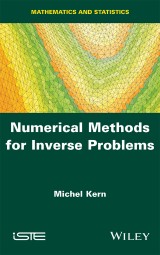Details
Numerical Methods for Inverse Problems
1. Aufl.
|
139,99 € |
|
| Verlag: | Wiley |
| Format: | EPUB |
| Veröffentl.: | 31.03.2016 |
| ISBN/EAN: | 9781119136965 |
| Sprache: | englisch |
| Anzahl Seiten: | 228 |
DRM-geschütztes eBook, Sie benötigen z.B. Adobe Digital Editions und eine Adobe ID zum Lesen.
Beschreibungen
<p>This book studies methods to concretely address inverse problems. An inverse problem arises when the causes that produced a given effect must be determined or when one seeks to indirectly estimate the parameters of a physical system.</p> <p>The author uses practical examples to illustrate inverse problems in physical sciences. He presents the techniques and specific methods chosen to solve inverse problems in a general domain of application, choosing to focus on a small number of methods that can be used in most applications.</p> <p>This book is aimed at readers with a mathematical and scientific computing background. Despite this, it is a book with a practical perspective. The methods described are applicable, have been applied, and are often illustrated by numerical examples.</p>
<p>Preface ix</p> <p><b>Part 1. Introduction and Examples 1</b></p> <p><b>Chapter 1. Overview of Inverse Problems </b> <b>3</b></p> <p>1.1. Direct and inverse problems 3</p> <p>1.2. Well-posed and ill-posed problems 4</p> <p><b>Chapter 2. Examples of Inverse Problems 9</b></p> <p>2.1. Inverse problems in heat transfer 10</p> <p>2.2. Inverse problems in hydrogeology 13</p> <p>2.3. Inverse problems in seismic exploration 16</p> <p>2.4. Medical imaging 21</p> <p>2.5. Other examples 25</p> <p><b>Part 2. Linear Inverse Problems 29</b></p> <p><b>Chapter 3. Integral Operators and Integral Equations 31</b></p> <p>3.1. Definition and first properties 31</p> <p>3.2. Discretization of integral equations 36</p> <p>3.2.1. Discretization by quadrature–collocation 36</p> <p>3.2.2. Discretization by the Galerkin method 39</p> <p>3.3. Exercises 42</p> <p><b>Chapter 4. Linear Least Squares Problems – Singular Value Decomposition 45</b></p> <p>4.1. Mathematical properties of least squares problems 45</p> <p>4.1.1. Finite dimensional case 50</p> <p>4.2. Singular value decomposition for matrices 52</p> <p>4.3. Singular value expansion for compact operators 57</p> <p>4.4. Applications of the SVD to least squares problems 60</p> <p>4.4.1. The matrix case 60</p> <p>4.4.2. The operator case 63</p> <p>4.5. Exercises 65</p> <p><b>Chapter 5. Regularization of Linear Inverse Problems 71</b></p> <p>5.1. Tikhonov’s method 72</p> <p>5.1.1. Presentation 72</p> <p>5.1.2. Convergence 73</p> <p>5.1.3. The L-curve 81</p> <p>5.2. Applications of the SVE 83</p> <p>5.2.1. SVE and Tikhonov’s method 84</p> <p>5.2.2. Regularization by truncated SVE 85</p> <p>5.3. Choice of the regularization parameter 88</p> <p>5.3.1. Morozov’s discrepancy principle 88</p> <p>5.3.2. The L-curve 91</p> <p>5.3.3. Numerical methods 92</p> <p>5.4. Iterative methods 94</p> <p>5.5. Exercises 98</p> <p><b>Part 3. Nonlinear Inverse Problems 103</b></p> <p><b>Chapter 6. Nonlinear Inverse Problems – Generalities 105</b></p> <p>6.1. The three fundamental spaces 106</p> <p>6.2. Least squares formulation 111</p> <p>6.2.1. Difficulties of inverse problems 114</p> <p>6.2.2. Optimization, parametrization, discretization 114</p> <p>6.3. Methods for computing the gradient – the adjoint state method 116</p> <p>6.3.1. The finite difference method 116</p> <p>6.3.2. Sensitivity functions 118</p> <p>6.3.3. The adjoint state method 119</p> <p>6.3.4. Computation of the adjoint state by the Lagrangian 120</p> <p>6.3.5. The inner product test 123</p> <p>6.4. Parametrization and general organization 123</p> <p>6.5. Exercises 125</p> <p><b>Chapter 7. Some Parameter Estimation Examples 127</b></p> <p>7.1. Elliptic equation in one dimension 127</p> <p>7.1.1. Computation of the gradient 128</p> <p>7.2. Stationary diffusion: elliptic equation in two dimensions 129</p> <p>7.2.1. Computation of the gradient: application of the general method 132</p> <p>7.2.2. Computation of the gradient by the Lagrangian 134</p> <p>7.2.3. The inner product test 135</p> <p>7.2.4. Multiscale parametrization 135</p> <p>7.2.5. Example 136</p> <p>7.3. Ordinary differential equations 137</p> <p>7.3.1. An application example 144</p> <p>7.4. Transient diffusion: heat equation 147</p> <p>7.5. Exercises 152</p> <p><b>Chapter 8. Further Information 155</b></p> <p>8.1. Regularization in other norms 155</p> <p>8.1.1. Sobolev semi-norms 155</p> <p>8.1.2. Bounded variation regularization norm 157</p> <p>8.2. Statistical approach: Bayesian inversion 157</p> <p>8.2.1. Least squares and statistics 158</p> <p>8.2.2. Bayesian inversion 160</p> <p>8.3. Other topics 163</p> <p>8.3.1. Theoretical aspects: identifiability 163</p> <p>8.3.2. Algorithmic differentiation . 163</p> <p>8.3.3. Iterative methods and large-scale problems 164</p> <p>8.3.4. Software 164</p> <p>Appendices 167</p> <p>Appendix 1 169</p> <p>Appendix 2 183</p> <p>Appendix 3 193</p> <p>Bibliography 205</p> <p>Index 213</p>
<p>"The book is very carefully written, in a reader-friendly style. It can be considered as an introductory textbook for the theory of ill-posed problems and their numerical solution." (<i>Mathematical Reviews/MathSciNet</i> 11/05/2017)</p>
<p><b>Michel Kern</b> is a research scientist in the Serena group at the Inria Research Center in Paris, France</p>


















